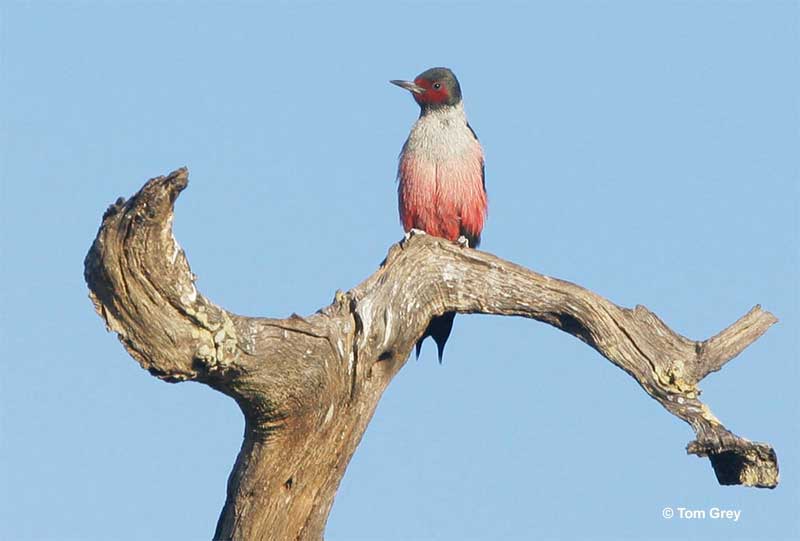
Even though Oklahoma is in the middle grounds, this doesn’t mean there are not many woodpeckers – quite the contrary, this state is loved by many species.
Some of them come to our back gardens, while others are more solitary and do not like to be around us; there’s plenty to explore!
Oklahoma’s Woodpecker Populations
Woodpeckers live in more places than you think! In Oklahoma, woodpeckers are in every woodland and even areas with scattered trees. Go birding in eastern forests to see Pileated Woodpeckers, and in brushy western habitats to see Ladder-backed and Golden-fronted Woodpeckers.
Northern Flickers and gorgeous Red-headed Woodpeckers show their colors and sound off in parks and other semi-open areas. Have a backyard with big trees? Watch for Downy, Hairy, and Red-bellied Woodpeckers!
Woodpeckers need trees and other native vegetation, especially snags and dead trees. Look for those cues, and you’ll find woodpeckers drumming and calling from high perches.
In order to give you the perfect overview, we used eBird data to get a sense of some numbers and recent spottings.
Downy Woodpecker

Scientific name: Dryobates pubescens
Length: 6.75 inches
Wingspan: 12 inches
Downy Woodpeckers are small, cute woodpeckers with black and white plumage. They have bold, black and white markings on their heads, black and white wings, and white underparts.
They also have a white back, black rump, and black and white tail. This woodpecker is slightly bigger than a sparrow, and has white, tufted feathers above its short beak.
Male Downy Woodpeckers have a small red patch on the back part of their head. Females look like males but lack this red patch, and young birds have red on the top of their heads.
This small bird is common in all sorts of wooded habitats. They like to use their small beaks to peck into twigs and often forage with flocks of chickadees and other birds.
Downy Woodpeckers are regular visitors to backyards and can live in urban areas with lots of trees.
Key identifications:
- Downy Woodpeckers are smaller than all other woodpeckers in North America. They are nearly as small as a House Sparrow.
- This species has a short and stubby beak (for a woodpecker).
- Downy Woodpeckers have small dark markings on their white outer tail feathers.
Red-bellied Woodpecker
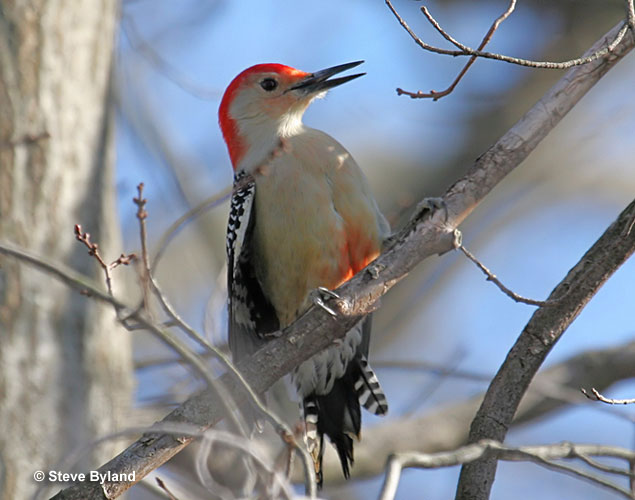
Scientific name: Melanerpes carolinus
Length: 9.25 inches
Wingspan: 16 inches
Red-bellied Woodpeckers are bold birds with a long, dark, chisel-like beak, and backs with zebra-like barring. They also have black and white bars on their long, closed wings, and a bold white rump with some black speckling.
Despite their name, it’s really hard to see the red on this bird’s underparts! Although they do have a bit of red or reddish-orange, it’s hidden on the lower part of their belly. The rest of their underparts and face are a pale gray-buff color, and they have a bit of orange above their beak.
Male Red-bellied Woodpeckers have bright red on their crown and nape. Females only have red on their nape and young birds only show a bit of orange on the back of their head.
We see pairs of this common woodpecker species in all sorts of woodlands. As long as big trees are present, they can even live in urban areas, and often come to feeders.
Along with Downy Woodpeckers, Red-bellied Woodpeckers are incredibly common in Oklahoma.
Key identifications:
- In most of their range, Red-bellied Woodpeckers are the only woodpecker species that has zebra-like, black and white barring on their back and wings.
- Red-bellied Woodpeckers have a pale face and red on their nape.
- This species has plain buff-gray underparts.
Northern Flicker

Scientific name: Colaptes auratus
Length: 12.5 inches
Wingspan: 20 inches
Northern Flickers are big, unique, gray and tan woodpeckers with bold white rumps. They have buff underparts with black spotting and a bold black patch on their chest, and fine black barring on their back and wings.
This species has some differences depending on where they live. Birds east of the Rocky Mountains have a small red spot on their nape, and a black moustache mark (males). Eastern birds also have bright yellow underwings.
West of the Rockies, Northern Flickers have grayer heads, and males have a red moustache. They also have reddish on their underwings.
Northern Flickers love parks, golf courses, and other semi-open habitats. In such places, we often see them in bounding flight, or perched on the ground as they forage for ants. These noisy birds also make laughing calls and “wicka-wicka” vocalizations.
Key identifications:
- In most of their range, Northern Flickers are the only woodpecker with gray and brown plumage.
- This species has a gray crown and fine black barring on its tan-colored back.
- Northern Flickers also have a black chest patch and black spotting on their underparts.
Pileated Woodpecker
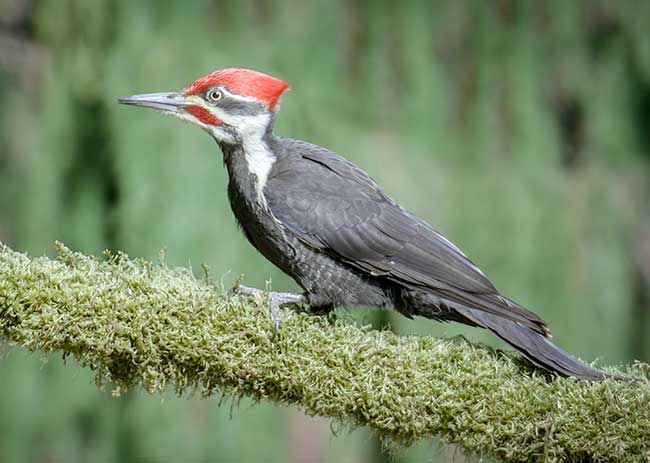
Scientific name: Dryocopus pileatus
Length: 16.5 inches
Wingspan: 29 inches
Pileated Woodpeckers are really big woodpeckers. These hefty birds are nearly the same size as an American Crow!
If the Ivory-billed Woodpecker is actually extinct, that makes the Pileated Woodpecker the biggest woodpecker in North America.
These unmistakable woodpeckers are mostly black with a thick white line on each side of their neck, and a white throat.
They also have a red crest and a long, grayish beak. Males have a small red moustache while females have a black line that extends from their beak to their neck.
Pileated Woodpeckers also have a small white patch on the upper part of each wing. It’s easier to see this mark and the white underwings when the big woodpecker takes flight.
This fantastic woodpecker lives in forests and woodlands with lots of big, mature trees. For that reason, we don’t usually see them in urban areas. However, they can visit feeders at houses next to or within forest!
Key identifications:
- In most places, Pileated Woodpeckers are the only big black and white woodpecker with a red crest.
- This species has a small white patch near the tip of each upperwing. They also have white wing linings.
- Pileated Woodpeckers have a lot of white on their face and a completely black back.
Red-headed Woodpecker

Scientific name: Melanerpes erythrocephalus
Length: 9.25 inches
Wingspan: 17 inches
Red-headed Woodpeckers are beautiful, medium-sized woodpeckers with a completely deep red head. Adults of both sexes look alike and have a sharp gray bill, and bright white underparts.
Their upperparts are glossy black with a snow-white rump, and big white patches on their wings. Juvenile Red-headed Woodpeckers have a similar plumage pattern but have a gray-brown head, and some dark markings on their wings and underparts.
This striking bird prefers semi-open habitats with mature oaks, snags, and other big trees. We see them on golf courses, at the edges of rivers and other wetlands, and other places with similar-looking habitat.
In some places, this beautiful bird also occurs in urban areas, especially in the southeastern USA.
Red-headed Woodpeckers like to peck into trees like other woodpeckers but they also catch insects in flight. With that in mind, we often see them sallying into the air from tall snags next to open areas.
Key identifications:
- Red-headed Woodpeckers are the only woodpecker species in eastern North America with an entirely red head.
- This species has a unique wing pattern with big white patches on the base of each wing.
- The Red-headed Woodpecker has a black tail and an extensive white rump.
Hairy Woodpecker
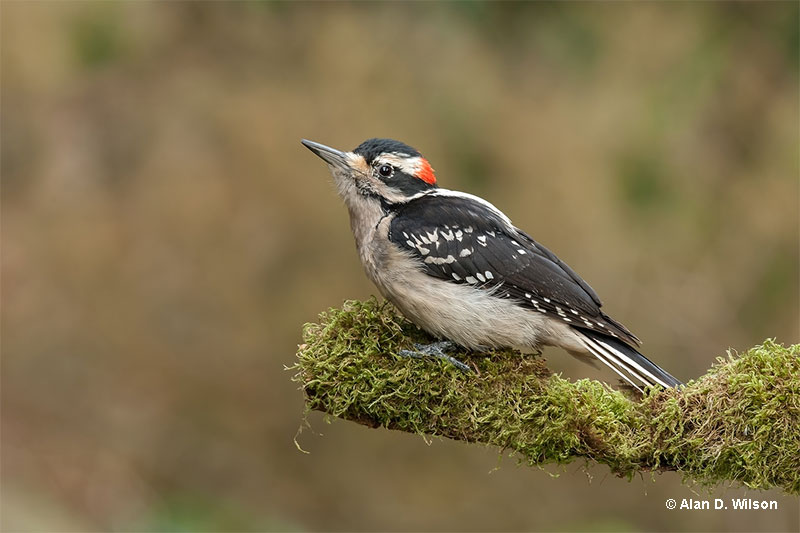
Scientific name: Dryobates villosus
Length: 9.25 inches
Wingspan: 15 inches
Hairy Woodpeckers are medium-sized, black and white woodpeckers with a fairly long and sharp beak. They have a bold black and white pattern on their head, white back, black rump, and black and white wings.
Hairy Woodpeckers also have white underparts and a pale front. Males have a small red patch on the back of their head, females lack this patch, and juveniles have a red patch on top of their head.
If that description sounds like a Downy Woodpecker, it’s true, these two species look almost exactly the same! However, in addition to details mentioned below, they also differ in another main way.
While Downy Woodpeckers like second growth and plants with thin stems, Hairy Woodpeckers only live in places with big, mature trees. We mostly find these woodpeckers in forest but they can also occur in parks and suburban areas that have lots of big trees.
Hairy Woodpeckers can also visit feeders, especially for suet.
Key identifications:
- Hairy Woodpeckers have noticeably longer beaks than Downy Woodpeckers, and are also larger birds.
- The Hairy Woodpecker has a big white patch on its back.
- This species has plain white underparts and clean white outer tail feathers.
Yellow-bellied Sapsucker
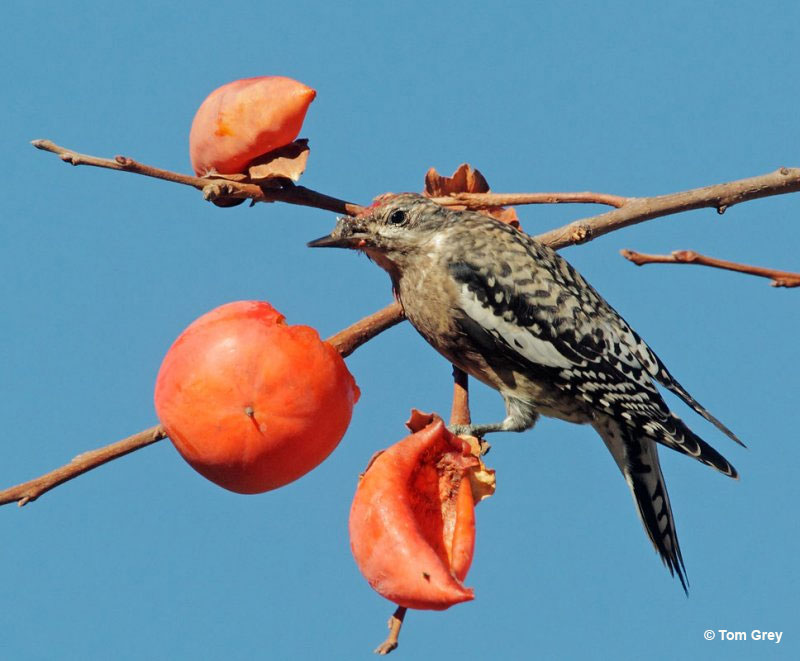
Scientific name: Sphyrapicus varius
Length: 8.5 inches
Wingspan: 16 inches
Yellow-bellied Sapsuckers are pretty, medium-sized woodpeckers with white shoulders. They have a black and white face, black chest, and uneven black and white barring on their backs.
This woodpecker species has pale yellow on its underparts, small black markings on its sides, and a red patch on its head.
Males also have a red throat bordered with black while females have a white throat. Juvenile Yellow-bellied Sapsuckers look like adults but are more dingy gray-brown, and lack red on their heads.
This migratory species likes to peck rows of small holes in deciduous trees. It drinks the sap that comes out as well as insects attracted to the sap.
Yellow-bellied Sapsuckers breed in northern and montane forests, and spend the winter in parks and a variety of woodland habitats from the southeastern USA to Central America.
On their breeding grounds, we often hear their distinctive tapping that starts with a few fast taps and then slows down.
Key identifications:
- Yellow-bellied Sapsuckers are the only woodpeckers in most of their range with white shoulders.
- This species has a black chest and uneven barring on its sides.
- The Yellow-bellied Sapsucker has lots of uneven, mottled black and white barring on its back.
Ladder-backed Woodpecker
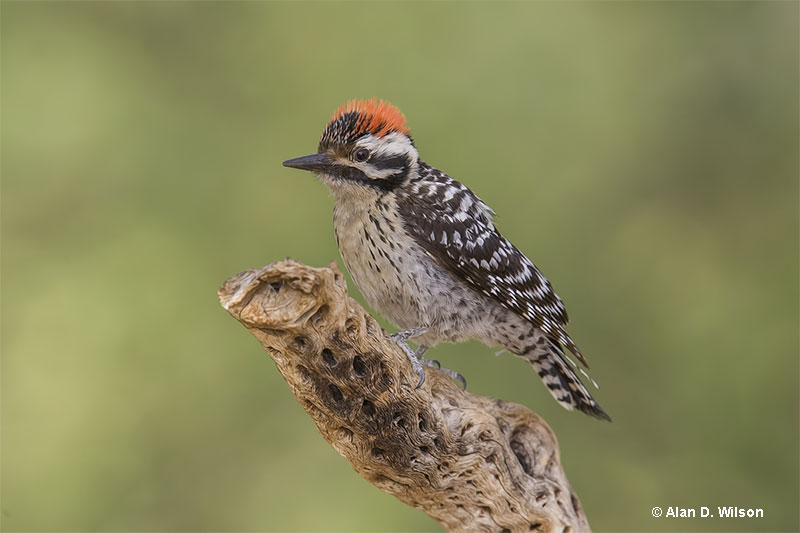
Scientific name: Dryobates scalaris
Length: 7.25 inches
Wingspan: 13 inches
The Ladder-backed Woodpecker is a small, black and white woodpecker of arid zones. It has a black and white “zebra” pattern on its back and wings, and some black speckling on off-white underparts.
Ladder-backed Woodpeckers also have a pair of thick black lines on their face, buff front, and a sharp, medium length beak. Males and juveniles have a red patch on the top of their head while females have a black crown.
Pairs of this small woodpecker pick insects and other arthropods from cactus and the trunks and branches of scrubby vegetation and small trees. They don’t peck into bark as much as other woodpeckers, and females forage more on twigs while males stick to trunks and larger branches.
Ladder-backed Woodpeckers are common in deserts and scrubby arid habitats. We find this handsome little woodpecker in many parts of the American Southwest as well as Texas north to southeastern Colorado.
Key identifications:
- Barred, black and white back.
- Two black lines on a pale face.
- Some black speckling on pale buffy underparts.
Golden-fronted Woodpecker
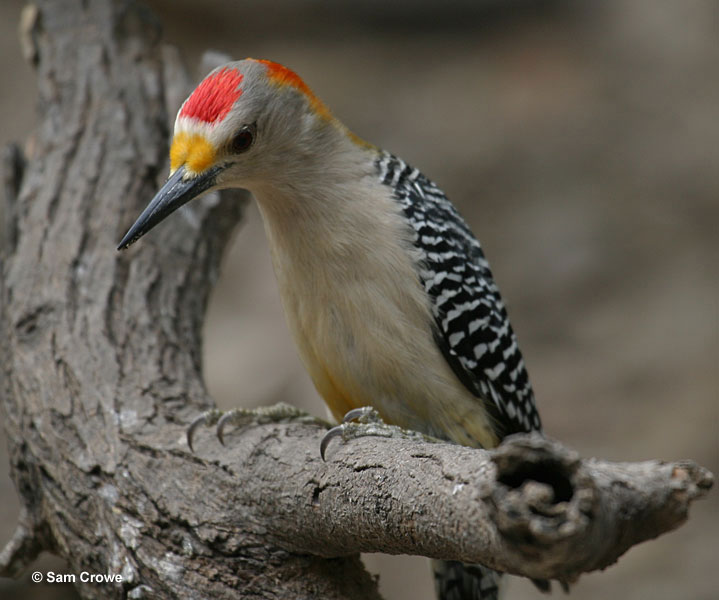
Scientific name: Melanerpes aurifrons
Length: 9.5 inches
Wingspan: 17 inches
Golden-fronted Woodpeckers are like the Red-bellied Woodpeckers of western Oklahoma and central and southern Texas. They replace the common species in those regions and have similar behaviors.
Golden-fronted Woodpeckers have fine black and white barring on their back and wings, a white rump, black tail, and a long, black beak. They have a buff-gray head with an orange-yellow nape and golden front, and males have a red crown.
The rest of their underparts are buff-gray with some yellow on their belly. These beautiful birds are common in arid brushy habitats and subtropical woodlands.
Golden-fronted Woodpeckers are adaptable birds that feed on insects, fruit, seeds, and other food items. They can also visit feeders and occasionally eat small lizards and other bird’s eggs.
Key identifications:
- Black and white barring on back and dark yellow nape.
- Bright white rump.
- Black tail.
Red-cockaded Woodpecker
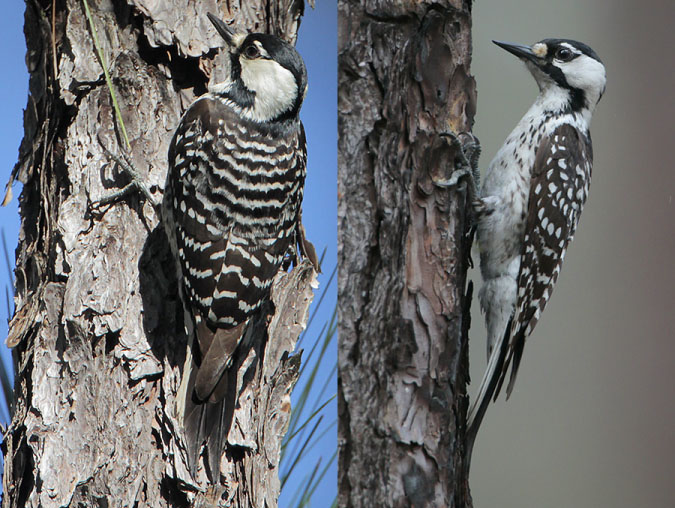
Scientific name: Dryobates borealis
Length: 8 inches
Wingspan: 14.2 inches
Red-cockaded Woodpeckers are smallish, black and white woodpeckers with black and white barring on their backs. They have a big white patch on each side of their head, a thick black moustache mark, and white underparts with small black markings on their sides.
Despite their name, it’s pretty hard to see the red on this bird! It takes a close, careful look to see the small red spot on the male’s head.
Red-cockaded Woodpeckers are locally common at scattered sites in the southeastern USA. It used to be much more common but declined as old growth forests were logged throughout its range.
This species lives in small social groups and requires mature Longleaf Pines for nesting. Unlike other birds, Red-cockaded Woodpeckers only nest in live pines because the resin or pine sap that comes out of their holes helps protect their nests from snakes.
In Oklahoma, they live only in the southeast, in the McCurtain County Wilderness Area and Ouachita National Forest, but their populations are not high.
Key identifications:
- Each side of the Red-cockaded Woodpecker’s head is mostly white. Unlike several other black and white woodpeckers, it does not have a black line going back from the eye.
- This species has black and white barring on its back.
- Red-cockaded Woodpeckers have small black markings on their sides.
Red-naped Sapsucker (rare)
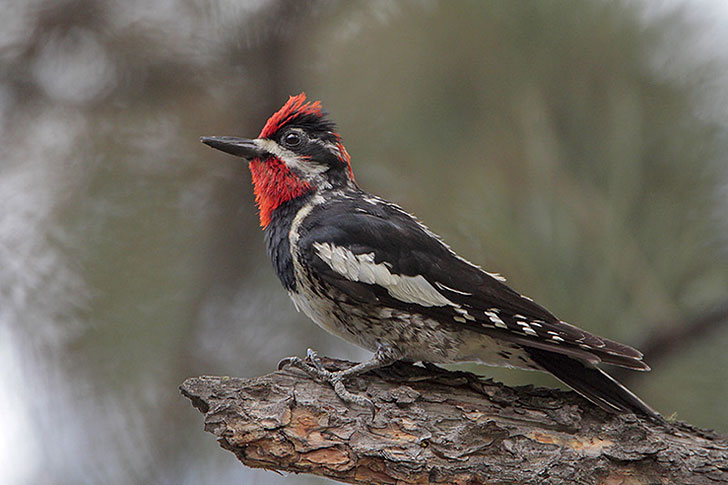
Scientific name: Sphyrapicus nuchalis
Length: 8.5 inches
Wingspan: 16 inches
Red-naped Sapsuckers are beautiful woodpeckers with a medium-length beak, black chest patch, and pale yellow underparts. They have a boldly patterned black and white face with a red spot on their nape, and red on their crown and throat.
This species also has a mottled black and white back, some fine black marks on its sides, and white patch on the front of each wing. Juveniles lack bright colors, and are brownish on their head and underparts.
Red-naped Sapsuckers live in a variety of woodland habitats including aspen groves and riparian zones. Like other sapsucker species, they tap small holes in trees to drink the sap and eat insects attracted to it.
This woodpecker also eats aspen buds, some fruit, and insects that it catches by pecking into bark and sallying into the air.
Red-naped Sapsuckers breed in the Rocky Mountain region and winter at lower elevations from Nevada to Mexico.
Key identifications:
- Red on throat and nape.
- Black chest and pale yellow belly.
- White patch on the front of each wing.
Lewis’s Woodpecker (rare)
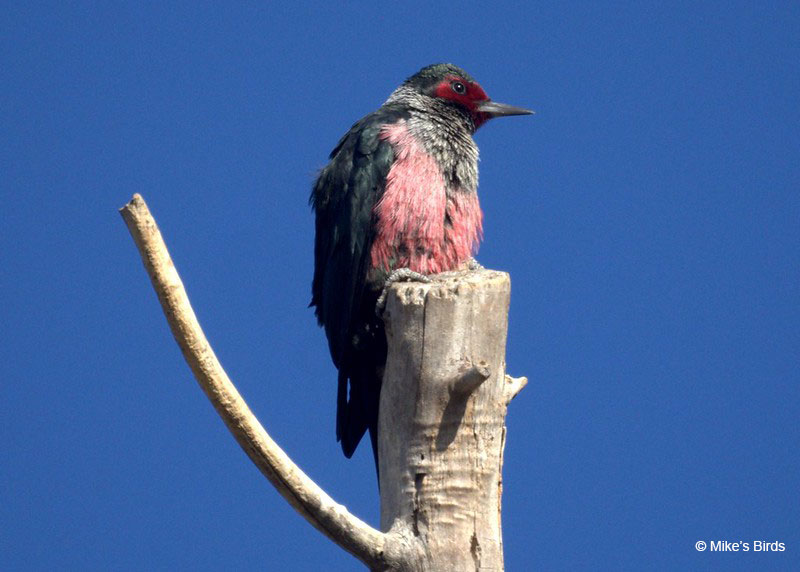
Scientific name: Melanerpes lewis
Length: 10.75 inches
Wingspan: 21 inches
The Lewis’s Woodpecker is a unique, fairly large woodpecker with a dark red face, silver-gray collar and chest, and magenta-pink underparts. The rest of its plumage is blackish green.
Both sexes look alike while juveniles lack bright colors and have brownish heads.
Unlike most woodpecker species, the Lewis’s Woodpecker prefers semi-open areas with big, scattered trees. They are especially common in open Ponderosa Pine forests, riparian zones with big Cottonwoods, and burned areas.
Oddly enough, since Lewis’s Woodpeckers aren’t good at excavating holes in hard wood, they require old, decayed trees for nesting. In summer, this species also needs areas with plenty of insects.
Lewis’s Woodpeckers usually live in the west, but in some rare cases, they can be spotted in Oklahoma.
Key identifications:
- Blackish, glossy green plumage.
- Pink belly.
- Silvery collar.
Frequently Asked Questions
How many woodpeckers does Oklahoma have?
Oklahoma has 15 woodpeckers on the official state bird list. However, one of those species, the Ivory-billed Woodpecker, is extinct in the state and a few others are rare visitors.
Where can you find woodpeckers in Oklahoma?
You can find woodpeckers in Oklahoma in woodlands, and any area with big trees, anywhere in the state.
Do Oklahoma woodpeckers migrate?
Most Oklahoma woodpeckers do not migrate. A couple species wander to the state, and one species, the Yellow-bellied Sapsucker migrates to Oklahoma for the winter.
More in Oklahoma: Most common birds | Owls | State Bird

